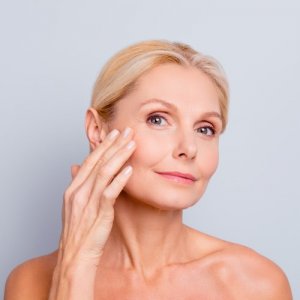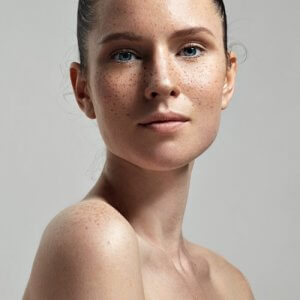You may know that your skin type plays a role in skin care, but unfortunately, most people don’t know their own skin type – or even what the different skin types are. According to Dr. Carmen Julian of U.S. Dermatology Partners in Austin, Texas, “Many people either haven’t identified or have misidentified their skin type, which leads to using the wrong products resulting in a negative outcome. Without proper skin care, people may notice increases in the signs of aging, skin irritation, more frequent breakouts, flare-ups in chronic skin conditions, and other skin health issues. It’s amazing how much better people look and feel after they work with a dermatologist to identify their skin type and adjust their skincare routines to fit their type.” You can learn more about the different skin types in this blog, and don’t hesitate to reach out to Dr. Julian or one of the other knowledgeable dermatologists at U.S. Dermatology Partners to learn more.
Skin Type 1 – “Normal” Or Balanced

After cleaning and drying the skin and before applying any cosmetics, the normal skin type has the following characteristics:
- Even complexion
- Soft, smooth appearance
- Minimally visible pores
- No dry or scaly skin patches
- No oily or shiny areas of skin
- Little to no product sensitivity
Skin Type 2 – Dry

After cleaning and drying skin and before applying any cosmetics, the dry skin type has the following characteristics:
- Redness, paleness, or generally uneven complexion
- Skin appears dull or flat
- Skin may be dry even in areas that are typically oily like the T-Zone (forehead, nose, and chin)
- Ashy or noticeably dry areas of skin
- Skin feels taught or doesn’t seem to move naturally
- Skin may itch or be prone to hives
- Cracked or broken areas of skin
- Thickened patches of skin called plaques or tough, callused areas may develop over time
- Because the skin’s protective, moisture barrier is often insufficient, people with dry skin may be very sensitive to skincare products
Skin Type 3 – Oily

After cleaning and drying the skin and before applying any cosmetics, the oily skin type has the following characteristics:
- Skin appears shiny
- Skin feels oily or greasy
- Can see oil or residue when you use a blotting paper
- Visibly enlarged pores
- Skin may look pale in areas that produce more oil
- Skin can thicken in oily areas
- The extra-moisturized skin means minimal risk of adverse response to skincare products
Skin Type 4 – Combination

After cleaning and drying the skin and before applying any cosmetics, the combination skin type has the following characteristics:
- Dry and oily patches of skin may be visible simultaneously
- Fluctuation between dry and oily skin at different times (may be related to environmental factors, changes in skincare routines, or biological shifts)
- The T-Zone (forehead, nose, chin) tends to be oily and have larger, more visible pores
- The cheeks and outsides of the face tend to be dryer
- Skin is sensitive or tends to flare-up in oily or dry areas (treating oiliness leads to excessive dryness and treating dryness leads to excessive oiliness)
Skin Type Sub-Categories
In addition to these four main skin types, some sub-categories may characterize your skin and impact your skincare needs. They’re not really distinct skin types because people who fit into these sub-categories may have any of the four skin types.
Some of the most common skin type sub-categories include:
- Sensitive skin – Characterized by its hyperreactivity to skincare products and other irritants and environmental factors, people with sensitive skin need to choose products that have few ingredients, contain no perfumes or dyes, and are naturally derived if possible. Before using a new product, people with sensitive skin should test it on a small area to check for an adverse response.
- Skin of color – People with darker skin tones can fall into any skin type. In addition to the skincare recommendations for their skin type, people with darker skin pigmentation may also need to look for and avoid using cosmetics and skincare products that including bleaching agents that may strip color, damaging their complexion.
- Acne-prone skin – Individuals with acne are prone to developing pimples, so they need to use products that are non-comedogenic (won’t cause pimples) to decrease their risk for a breakout.
- Other chronic skin conditions – In addition to acne, people with chronic skin conditions like eczema, rosacea, and psoriasis should work with a dermatologist to find products to address their skin health concerns while maintaining a generally healthy, beautiful appearance.
Caring for Your Skin
According to Dr. Julian, “Whatever you determine your skin type to be, you need to partner with a professional to create a personalized skincare routine that will help you protect your skin, minimize the signs of aging, and maintain optimal skin health. The over-the-counter and online market for skin care is inundated with products that boast guaranteed results. It is important to seek advice from a dermatologist who can guide you to greater skin and keep you from spending money on products that may be harmful.”
No matter what your skin type, your daily skincare routine should include the following simple steps:
- Step 1 – Use a gentle cleanser to wash your face, removing dirt, oil, cosmetics, and other debris from the skin, at least twice each day.
- Step 2 – Use personalized products and treatments as recommended for your skin type by a dermatologist. This may include exfoliating, applying deep moisture serums, and other products to help address skin health concerns.
- Step 3 – Moisturize. Yes, even people with oily or acne-prone skin need to apply moisturizer at least twice a day. To decrease oiliness or the risk of an acne breakout, look for oil-free or non-comedogenic products. People with dry or combination skin may need to use a thicker, cream-based moisturizer.
- Step 4 – Apply sunscreen or sunblock to protect the skin from daily sun exposure.
- Step 5 – Maintaining overall health helps keep your skin healthy. If the body isn’t healthy, it will redirect nutrients from the skin, so it’s important to take steps to maintain whole-body health. Specifically, individuals should eat nutritious foods, drink enough water, get plenty of sleep, and manage stress.
Visit U.S. Dermatology Partners
Whether you’re looking for help creating a personalized skincare routine or you’re struggling to manage a specific skin condition, the U.S. Dermatology Partners team is here to help. Get started scheduling your visit with one of our knowledgeable dermatologists by completing our online request form. Once we hear from you, we’ll be in touch to confirm your appointment details.
Find a location near me
or

